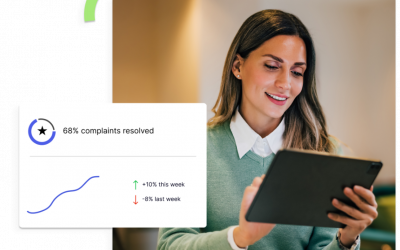For years, traditional business intelligence (BI) tools have helped organizations answer the question: “What happened?” These tools focused on descriptive analytics, summarizing historical data in charts and dashboards to help leaders understand performance trends.
But as data grew more complex and the need for faster, smarter decisions increased, descriptive alone wasn’t enough. Companies needed to know not just what happened, but why it happened. Enter diagnostic analytics, helping teams connect the dots and understand underlying drivers of success or inefficiency.
Now, with the rise of artificial intelligence and machine learning, we’re in the midst of a new leap forward. Predictive analytics uses algorithms to anticipate what may happen next – whether that’s forecasting turnover, flagging burnout risks, or identifying high-performer flight risk before it’s too late.
The next frontier? Prescriptive analytics, where tools help you identify the next actionable step to address workforce challenges. It’s about turning insight into foresight and helping teams respond proactively.
Why It Matters: The Analytics Maturity Model
As organizations move from information to optimization, each stage builds on the last – increasing in value, but also in complexity and the level of data readiness required.
Descriptive Analytics – What happened? This is the foundation. It summarizes past events and provides historical context – like headcount changes, time-to-fill, or turnover rates. It’s essential for understanding trends, but it stops at reporting.
Diagnostic Analytics – Why did it happen? Once you know what happened, the next step is figuring out why. Diagnostic analytics helps identify underlying causes. For example, analyzing exit survey patterns or correlating low engagement with poor manager effectiveness.
Predictive Analytics – What may happen? With the “what” and “why” in place, predictive analytics helps anticipate what’s coming. This is where AI models shine – forecasting attrition, surfacing burnout risks, and highlighting where you might see productivity shifts or resource gaps
Prescriptive Analytics – What should we do? The top of the curve – and the hardest to reach. Prescriptive analytics simulates outcomes and guides decision-makers toward the most effective action.
As organizations move up this model, they unlock increasing potential value from their data. While complexity grows, so does the ability to optimize operations, anticipate risks, and take action in real time, ultimately transforming how decisions are made.
How AI Enhances Business Intelligence
Artificial intelligence transforms traditional BI tools into smart, adaptive systems that do more than just report on the past. Here’s how AI is advancing business intelligence today:
- Faster analysis: AI algorithms process massive datasets in seconds, surfacing key insights with speed and accuracy.
- Improved data quality: Machine learning can identify anomalies, fill gaps, and cleanse datasets for more reliable outputs.
These innovations allow businesses to move from simply understanding what happened to preparing for what’s next and knowing exactly how to respond.
Choosing the Right Tools
Getting started with AI-powered analytics begins with choosing tools that are built to support it. Key features to look for include:
- System compatibility
- Scalability
- Customizability
- Ease of use
The most effective tools do not just offer AI capabilities – they embed them in a way that supports non-technical users and accelerates time to value.
Getting Started with AI-Powered BI
To make the most of AI in your analytics journey, here’s a step-by-step approach:
- Define clear goals
What do you want to solve or improve? Set clear objectives tied to specific business outcomes. - Build a strong data foundation
Ensure your data is clean, complete, and well-integrated across systems. - Use platforms with embedded AI
Avoid the heavy lift of building models from scratch. Look for tools with pre-built machine learning and natural language capabilities. - Start with a high-impact use case
Choose a focused, meaningful project, like identifying attrition risk, and build from there. - Create a culture of data literacy
Encourage teams to explore data independently and use insights to guide everyday decisions.
How ZeroedIn Can Help
ZeroedIn brings AI-powered analytics to workforce teams – no technical expertise required. Our platform helps organizations uncover real-time insights, make smarter decisions, and take action based on what matters most.
We know your data might live in different formats, systems, or spreadsheets – and that’s not your burden to carry. Whether it’s fragmented, outdated, or even partially paper-based, we handle the heavy lifting. ZeroedIn scrubs, organizes, and transforms your data behind the scenes so you can focus on what matters: making better people decisions.
And because we know what it takes to support real teams, our platform is designed with four key things in mind:
- System compatibility to meet you where you are
- Scalability to grow with you
- Customizability to surface the metrics that matter
- Ease of use so anyone on your team can dive in – no data science background required
With intuitive dashboards, explainable AI, and a human-first design, ZeroedIn helps turn hindsight into foresight faster.
🔍 Want to learn how ZeroedIn can unlock the power of your data? Send us a quick message.
Frequently Asked Questions
What is the difference between descriptive, diagnostic, predictive, and prescriptive analytics?
The difference lies in how each type of analytics answers a unique question. Descriptive analytics explains what happened using historical data, while diagnostic analytics explores why it happened by finding root causes. Predictive analytics uses AI and machine learning to forecast what may happen next, and prescriptive analytics recommends what actions to take for the best outcome. Together, these stages form the analytics maturity model that guides smarter business decisions.
How is AI transforming business intelligence?
AI is transforming business intelligence by turning static reports into intelligent systems that predict and guide decision-making. Instead of only showing past performance, AI-powered BI tools analyze data in real time, find hidden patterns, and suggest next steps. They also improve data quality by detecting errors and filling gaps automatically. This allows teams to move from simply understanding what happened to confidently planning what to do next.
Why does predictive analytics matter for organizations?
Predictive analytics matters because it helps organizations anticipate what’s coming instead of reacting after the fact. By using AI models to analyze patterns, businesses can forecast turnover, identify burnout risks, and plan for productivity shifts before they occur. This forward-looking view enables proactive decision-making and reduces costly surprises, making predictive analytics a key driver of strategic growth and resilience.
What should companies look for in AI-powered analytics tools?
Companies should look for AI-powered analytics tools that are compatible with existing systems, scalable for future growth, customizable to specific needs, and easy to use. The best tools embed AI features directly into their workflows, making insights accessible to both technical and non-technical users. This ensures faster adoption, shorter time to value, and a smoother path toward data-driven decision-making across teams.
How can ZeroedIn help businesses adopt AI-driven analytics?
ZeroedIn helps businesses adopt AI-driven analytics by simplifying the entire process from data preparation to insight delivery. The platform cleans, organizes, and integrates data from multiple sources, removing the burden of manual setup. With explainable AI, intuitive dashboards, and no need for technical expertise, ZeroedIn empowers workforce teams to uncover trends, predict risks, and act on insights quickly. It’s designed to help organizations turn hindsight into foresight with ease.





